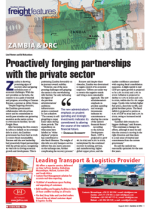Ec onomic growth in Zambia is expected to be underpinned by a 275% increase in copper output over the next nine years.Zambia remains in high debt distress, with debt above 104% of gross domestic product (GDP).The Zambian government plans to increase average output from around 800 000 metric tons a year to three million metric tons by 2032.This is despite the fact that copper production has been on a year-on-year decline since 2020.Production has fallen from 869 060 tons in 2020 to 800 700t in 2021 and 796 230t in 2022.This is ref lected in growth forecasts, with the Ministry of Finance estimating that the economy will grow by 2.7% in 2023 from 4.7% in 2022, due to contractions in mining and energy production.BMI puts the growth at 3.5%, accelerating to 3.9% in 2024.In July the Ministry of Finance and National Planning reported that it expected copper production, which accounts for more than 70% of export earnings, to drop a further 14% to 682 431 tons in 2023.It is the lowest level since 2009.Lower copper revenues mean that the government does not have the capital needed to invest in the logistics infrastructure needed to support a 275% increase in exports.It is also putting pressure on the social and economic fabric of the country, which is one of the poorest in the world.According to the German Federal Ministry for Economic Cooperation and Development (BMZ), more than half the population lives on less than $1.90 a day.The situation is worst in the rural areas, with Zambia having one of the highest malnutrition rates in Africa.The 2022 Global Hunger Index describes the situation in Zambia as “serious”, with 1% of the people being undernourished.Almost one-third (32.3%) of children under five suffer from stunting, with 6% dying before the age of five.The 2022 Global Hunger Index ranks Zambia 108th out of 121 countries.Even in good years, the copper industry supports relatively few jobs.In response to the challenges, the Zambian government is striving to achieve what BMZ calls “ambitious economic reforms to improve the climate for doing business and expand the agricultural sector”.The African Development Bank (Af DB) sees some green shoots in the focus on growing the agricultural industry.In its latest African Economic Outlook report, the Af DB states that real GDP recovered to 4.6% growth in 2021 and 3.0% in 2022 after contracting 2.8% in 2020.The recovery was driven mainly by wholesale and retail trade, agriculture, and mining and quarrying.Inf lation dropped from 22.1% in 2021 to 10.1% in 2022, driven mainly by the reduced food price shocks.“GDP is projected to grow 4.0% in 2023 and 4.2% in 2024, underpinned by the continued recovery in mining, services, and manufacturing; higher global copper prices; and the market confidence associated with ongoing fiscal consolidation measures,” states the Af DB.The International Monetary Fund warns that despite the positive signs, “with poverty and inequality amongst the highest in the world and Zambia’s high exposure to climate shocks, significant challenges remain.“To create a more conducive environment for private-sector development and attract much-needed private investment, strengthening economic governance and addressing corruption vulnerabilities should remain a central aspect of the government’s reforms, including implementing the recommendations of the IMF’s diagnostic Report on Governance and Corruption, published in December 2022.“Sustained efforts are also essential to maintain fiscal credibility while also creating sufficient space for social, development, and climate spending,” the IMF Executive Board warns after a review of the Zambian economic prospects.

